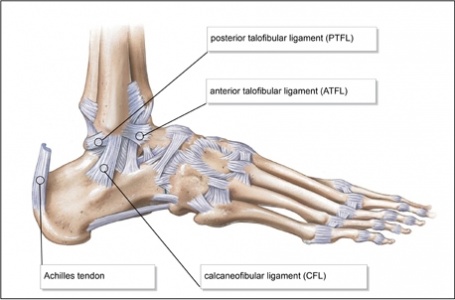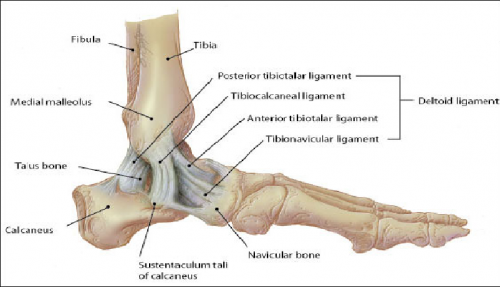Stress tests for Ankle ligaments: Difference between revisions
No edit summary |
No edit summary |
||
| Line 23: | Line 23: | ||
<u>''Medial Ankle Ligaments''</u> | <u>''Medial Ankle Ligaments''</u> | ||
The deltoid ligament is the only ligamentous complex stabilizing the medial side of the ankle. This complex is composed of two layers: superficial and deep. The superficial layer includes the tibinavicular, tibiocalcaneal and the posterior talotibial ligament. The deep layer is composed of deep posterior talotibial and deep anterior talotibial ligament. The deep layer has greater contribution to the stbaility of the ankle.<ref name="Aslan" /> The deltoid ligament as a whole has a dual function of providing stability to the talotibial joint as well as transferring forces between tibia and tarsus. It fixates the tibia above the talus and restricts the talus from shifting into a valgus postion, translating antero-laterally or rotating externally.<ref name="Stufkens">Stufkens SAS, van den Bekerom MPJ, Knupp M, Hintermann B, van Dijk CN. The diagnosis and treatment of deltoid ligament lesions in supination-external rotation ankle fractures:a review. Strat Traum Limb Recon. 2012 July 6;7:73-85</ref> | The deltoid ligament is the only ligamentous complex stabilizing the medial side of the ankle. This complex is composed of two layers: superficial and deep. The superficial layer includes the tibinavicular, tibiocalcaneal and the posterior talotibial ligament. The deep layer is composed of deep posterior talotibial and deep anterior talotibial ligament. The deep layer has greater contribution to the stbaility of the ankle.<ref name="Aslan" /> The deltoid ligament as a whole has a dual function of providing stability to the talotibial joint as well as transferring forces between tibia and tarsus. It fixates the tibia above the talus and restricts the talus from shifting into a valgus postion, translating antero-laterally or rotating externally.<ref name="Stufkens">Stufkens SAS, van den Bekerom MPJ, Knupp M, Hintermann B, van Dijk CN. The diagnosis and treatment of deltoid ligament lesions in supination-external rotation ankle fractures:a review. Strat Traum Limb Recon. 2012 July 6;7:73-85</ref> | ||
[[Image:Medial-ankle-ligaments.png|thumb|center|500x300px|Medial ankle ligaments]] | [[Image:Medial-ankle-ligaments.png|thumb|center|500x300px|Medial ankle ligaments]] | ||
The medial side of the ankle is considerably stronger than the lateral side. Injury to the medial ankle may even lead to fracture of the medial malleolus without a significant sprain to the deltoid ligament.<ref name="Aslan" /><br> | The medial side of the ankle is considerably stronger than the lateral side. Injury to the medial ankle may even lead to fracture of the medial malleolus without a significant sprain to the deltoid ligament.<ref name="Aslan" /><br> | ||
== Stress testing for Ligaments == | == Stress testing for Ligaments == | ||
1. Anterior Drawer Test | |||
It is used to assess the integrity of the ATFL based on the anterior translation of the talus under the tibia in a sagittal plane. | |||
Procedure: The patient is in supine lying or sitting position with the knee in flexed position to relax the calf muscles and prevent the patient from resisting the examiner. One hand of the examiner stabilizes the distal tibia and fibula while the other hand holds the calcaneum maintaining the ankle in a neutral position. A translatory force is applied on the calcaneum pulling it anteriorly while the tibia and fibula are pushed posteriorly. The test is perfomed on both sides and the two sides are compared. Excessive anterior translation of the talus on the injured side in comparison to the uninjured side indicates a positive test. A translation of more than 4-5mm on the injured would indicate a tear of ATFL. | |||
2. Talar tilt test | |||
It is also known as the inversion stress test and it stresses the calcaneo-fibular ligament, | |||
Procedure: The patient is positoned in sitting or supine lying with the knee in full extension. The examiner stabilizes the distal leg with one hand while the other hand holds the heel with the ankle in neutral position. The heel is inverted with respect to the tibia. It is important to hold the talus and calcaneum as one unit to prevent excessive subtalar movement. Pain in the area of the ligament or a sensation of clunk would indicate a positive test. An outward translation in excess of 5 degress on the injured side compared to the uninjured side, or a spongy or indefinite end feel indicate a complete tear of CFL. | |||
3. Eversion stress test | |||
It assesses the integrity of the deltoid ligament and is also know as the Eversion Talar Tilt test. | |||
Procedure: The patient is positioned similar to the Inversion stress test. The examiner everts and abducts the heel while stabilizing the distal tibia. The test is performed on both the sides. An increased laxity and pain on the injured side in comparison to the uninjured side would indicate a positive test. A spongy or indefinite end feel is indicative of a complete tear. | |||
Revision as of 20:43, 27 February 2017
Original Editor - Your name will be added here if you created the original content for this page.
Top Contributors - Vidhu Sindwani, Evan Thomas, Wanda van Niekerk, Rucha Gadgil, Kim Jackson and WikiSysop
Introduction[edit | edit source]
Ankle sprains are one of the most common musculoskeletal and sports-related injury, constituting nearly 25% of all musculoskeletal trauma cases and almost 40% of all sports-related trauma cases.[1] 40%-50% of these case have reported to have long term residual symptoms with almost 20% of acute ankle sprains developing chronic ankle instability. [2] Individuals with chronic instability often report recurrent sprains and 'giving-way' sensation at the ankle joint, a condition clinicall referred to as Functional Ankle Instability (FAI). [3] Several clinical tests can be used to assess FAI and the respective ligament involved in the acute sprain or chronic instability.
Relevant Anatomy[edit | edit source]
Ligaments of the ankle
Lateral ankle ligaments
The lateral side of the ankle has three supporting ligaments: the anterior talofibular (ATFL), the posterior talofibular (PTFL) and the calcaneofibular (CFL). The three ligaments are together called the Lateral Collateral Ligament Complex. The ATFL resists torsion and inversion stresses in a plantar flexed foot. It is the weakest and hence the most commonly injured part of the Lateral Collateral Ligament Complex. [1]
CFL is an extra-articular component of the complex. Its function is to resist torsion and inversion stresses in a dorsi-flexed foot. The PTFL resists posterior movement of the talus. It is the strongest and least injured part of the complex. Injuries to PTFL usually occur in severe ankle sprains which also involve the ATFL and CFL.[4]
Medial Ankle Ligaments
The deltoid ligament is the only ligamentous complex stabilizing the medial side of the ankle. This complex is composed of two layers: superficial and deep. The superficial layer includes the tibinavicular, tibiocalcaneal and the posterior talotibial ligament. The deep layer is composed of deep posterior talotibial and deep anterior talotibial ligament. The deep layer has greater contribution to the stbaility of the ankle.[1] The deltoid ligament as a whole has a dual function of providing stability to the talotibial joint as well as transferring forces between tibia and tarsus. It fixates the tibia above the talus and restricts the talus from shifting into a valgus postion, translating antero-laterally or rotating externally.[5]
The medial side of the ankle is considerably stronger than the lateral side. Injury to the medial ankle may even lead to fracture of the medial malleolus without a significant sprain to the deltoid ligament.[1]
Stress testing for Ligaments[edit | edit source]
1. Anterior Drawer Test
It is used to assess the integrity of the ATFL based on the anterior translation of the talus under the tibia in a sagittal plane.
Procedure: The patient is in supine lying or sitting position with the knee in flexed position to relax the calf muscles and prevent the patient from resisting the examiner. One hand of the examiner stabilizes the distal tibia and fibula while the other hand holds the calcaneum maintaining the ankle in a neutral position. A translatory force is applied on the calcaneum pulling it anteriorly while the tibia and fibula are pushed posteriorly. The test is perfomed on both sides and the two sides are compared. Excessive anterior translation of the talus on the injured side in comparison to the uninjured side indicates a positive test. A translation of more than 4-5mm on the injured would indicate a tear of ATFL.
2. Talar tilt test
It is also known as the inversion stress test and it stresses the calcaneo-fibular ligament,
Procedure: The patient is positoned in sitting or supine lying with the knee in full extension. The examiner stabilizes the distal leg with one hand while the other hand holds the heel with the ankle in neutral position. The heel is inverted with respect to the tibia. It is important to hold the talus and calcaneum as one unit to prevent excessive subtalar movement. Pain in the area of the ligament or a sensation of clunk would indicate a positive test. An outward translation in excess of 5 degress on the injured side compared to the uninjured side, or a spongy or indefinite end feel indicate a complete tear of CFL.
3. Eversion stress test
It assesses the integrity of the deltoid ligament and is also know as the Eversion Talar Tilt test.
Procedure: The patient is positioned similar to the Inversion stress test. The examiner everts and abducts the heel while stabilizing the distal tibia. The test is performed on both the sides. An increased laxity and pain on the injured side in comparison to the uninjured side would indicate a positive test. A spongy or indefinite end feel is indicative of a complete tear.
Recent Related Research (from Pubmed)[edit | edit source]
Extension:RSS -- Error: Not a valid URL: Feed goes here!!|charset=UTF-8|short|max=10
References[edit | edit source]
References will automatically be added here, see adding references tutorial.
- ↑ 1.0 1.1 1.2 1.3 Aslan A, Sofu H, Kirdemir V. Ankle Ligament Injury: Current concept. OA Orthopaedics. 2014 March 11; 2(1):5
- ↑ Chan KE. Acute and Chronic Lateral Ankle Instability in the Athlete. Bulletin of the NYU hospital for joint diseases. 2011;69(1):17-26
- ↑ Ross SE, Guskiewicz KM, Gross MT. Assessment tools for identifying functional limitations associated with functional ankle instability. Journal of athletic training. 2008 Feb;43(1):44-50.
- ↑ Lynch S. Assessment of the injured ankle in the athlete. Journal of Athletic training. 2002 Dec;37(4):406-412
- ↑ Stufkens SAS, van den Bekerom MPJ, Knupp M, Hintermann B, van Dijk CN. The diagnosis and treatment of deltoid ligament lesions in supination-external rotation ankle fractures:a review. Strat Traum Limb Recon. 2012 July 6;7:73-85








